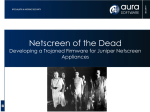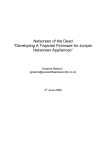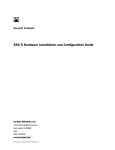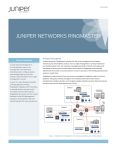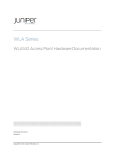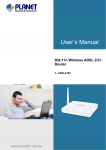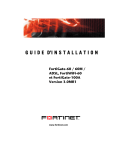Download Netscreen of the Dead & Return of the Living Fortigate
Transcript
Netscreen of the Dead & Return of the Living Fortigate Cast Graeme Neilson :: Script Security Consultant Aura Software Security [email protected] Juniper Inc :: Patient Zero Network Security Appliance Vendor www.juniper.net Fortinet Inc :: Victim Two Network Security Appliance Vendor www.fortinet.com Trailer • What if a core network security device was compromised? – an attacker has exploited a vulnerability – malicious third party support – malicious appliance supplier – malicious or socially engineered employee • Different approach from remote exploits as these appliances are not normally accessible from non management networks. • Goal is hidden root control of the appliance. – Discuss reversing and modifying appliance firmware. – Demo a zombie Netscreen and Fortigate (Troopers exclusive) Opening Scene Netscreens are manufactured by Juniper Inc • All in one Firewall, VPN, Router security appliance. • SME to Datacentre scale (NS5XP – NS5400). • Common Criteria and FIPS certified. • Run a closed source, real time OS called ScreenOS. • ScreenOS is supplied as a binary firmware 'blob'. NS5XT Model: • PowerPC 405 GP RISC processor 64MB Flash • Serial console, Telnet, SSH, HTTP/HTTPS admin interfaces Attack Attacking firmware - two vectors of attack: • Live evisceration: debugging with remote GDB debugger over serial line. • Feeding on the remains: dead listing / static binary analysis using disassembler and hex editor of firmware. PowerPC architecture: • fixed instruction size of 4 bytes • flat memory model • 32 GP registers, no explicit stack, link register • IBM PPC405 Embedded Processor Core User Manual Live Evisceration • Embedded Linux Development Kit has GDB compiled for PowerPC 405 processor • No source so create custom .gdbinit for PPC registers and 'stack' to provide 'SoftICE' like context on breaks. • Network connection to the Netscreen and run: set gdb enable • Connect remote gdb via serial console • Worked: – Memory dumps – Query memory addresses • Didn't work: – Breakpoints – Single stepping Feeding on the Remains /--------------------------\ ● | ● HEADER | Compared many different versions of ScreenOS firmware. Revealed a 4 section structure |--------------------------| | | ● |--------------------------| | STUB sig sysinfo 00000000: EE16BA81 00110A12 00000020 02860000 00000010: 004E6016 15100050 29808000 C72C15F7 size checksum | |--------------------------| | Header: | |--------------------------| | UNKNOWN size = compressed image size – 79 bytes sysinfo = 00, platform, cpu, version | |--------------------------| | | |--------------------------| | COMPRESSED BLOB | | ( BUB ) | \--------------------------/ ● ● Stub contains strings relating to LZMA compression algorithm. Version 6 uses gzip compression. Compressed Binary Update Blob (Bub) has a header. Bub • The header of the compressed binary update blob (Bub) appears to be a customised LZMA header. • Comparative analysis of different firmware version headers. • The standard LZMA header has 3 fields: options, dictionary_size, uncompressed_size • 'Bub' header has 3 fields: signature bytes, options, dictionary_size 00012BF0: 00000000 00000000 00000000 00000000 00012C00: 01440598 5D002000 00007705 92C63DFC 00012C10: 07046E0E 343AA6F1 899098E8 8EDAFDA8 Bub Can Change . Uncompress Bub ● Cut out the compressed blob from firmware. ● Insert an uncompressed_size field of value -1 == unknown size ● Modify the dictionary_size from 0x00200000 to 0x00008000 ● Then we can decompress the blob using freely available LZMA utilities Compress Bub ● Compress the binary with standard LZMA utilities. ● Modify the dictionary_size field from 0x00002000 to 0x00200000. ● Delete the uncompressed_size field of 8 bytes. ● Insert into original firmware file. Night of the Living Netscreen ● Cut out the compressed Bub section of the firmware. ● Uncompress Bub. ● Modify the resulting binary to add or change code and / or data. ● Re-compress the modified binary into a new Bub. ● Prepend the original Bub header to the new modified Bub. ● Successfully upload the modified firmware over serial. ● Cannot yet upload modified firmware via web interface due to an additional checksum validation. Autopsy • Uncompressed Bub is ~20Mb ScreenOS binary with a header. • Want to load into IDA but need a loading address so that references within the program point to the correct locations. • From header: program_entry = address – offset signature offset address 00000000: EE16BA81 00010110 00000020 00060000 00000010: 01440578 00000000 00000000 F8A2FA6F • Confirm with live debugging • Correctly loaded binary but unknown sections... Autopsy ii /--------------------------\ | HEADER ● | |--------------------------| | SCREENOS CODE | ● |--------------------------| | SCREENOS DATA | ● |--------------------------| | BOOT LOADER CODE | |--------------------------| | BOOT LOADER DATA | |--------------------------| | 0xFFs ● | ● |--------------------------| | other stuff! | \--------------------------/ ● Use IDA scripts to find function prologs (0x9421F*) and mark as code. Mark strings in data section for cross references. Use error strings to identify functions and rename. Search for str_cmp, file_read, file_write, login etc. Build up a picture of the binary structure and functions. Need to cut out boot loader and disassemble separately with loading address 0x0. Netscreen of the Dead • Modified ScreenOS firmware required functionality: – Install/Upgrade: Load any image via serial, tftp and web – Maintain Access: Include a back door login mechanism – Infection: Execute arbitrary code injected into the image • All modification hand crafted assembly inserted using a hex editor on the firmware. First Bite Install / Upgrade • Checksum and size in header are checked when images loaded over the network via the Web interface 00000000: EE16BA81 00110A12 00000020 02860000 00000010: 004E6016 15100050 29808000 C72C15F7 checksum • Checksum is calculated, could reverse the algorithm...but on firmware loading a bad checksum value is printed to the console. • What if we modify the image to print out the correct checksum value? we would have a 'checksum calculator' image which we load modified images against to calculate their checksums. • With correct checksum we can now load modified images via web interface. First Bite ii 008B60E4 lwz %r4, 0x1C(%r31) # %r4 contains header checksum 008B60E8 cmpw %r3, %r4 # %r3 contains calculated checksum 008B60EC beq loc_8B6110 # branch away if checksums matched #008B60EC mr %r4,%r3 # print out calculated checksum 008B60F0 lis %r3, aCksumXSizeD@h # " cksum :%x size :%d\n" 008B60F4 addi %r3, %r3, aCksumXSizeD@l 008B60F8 lwz %r5, 0x10(%r31) 008B60FC bl Print_to_Console # %r4 is printed to console 008B6100 lis %r3, aIncorrectFirmw@h # "Incorrect firmware data, 008B6104 addi %r3, %r3, aIncorrectFirmw@l 008B6108 bl Print_to_Console One Bit{e} Maintain Access • Console, Telnet, Web and SSH all compare password hashes and all use the same function. • SSH falls back to password if client does not supply a key unless password authentication has been disabled. • One bit patch provides login with any password if a valid username is supplied. One Bit{e} ii 003F7F04 mr %r4, %r27 003F7F08 mr %r5, %r30 003F7F0C bl COMPARE_HASHES 003F7F10 cmpwi %r3, 0 # equal if match #0x397F30 cmpwi %r3, 1 # equal if they don't match 003F7F14 bne loc_3F7F24 003F7F18 li %r0, 2 003F7F1C stw %r0, 0(%r29) 003F7F20 b loc_3F7F28 # does a string compare # login fails if not equal (branch) Infection Injecting code into the binary • ScreenOS code section contains a block of nulls • Proof of concept code injected into nulls Proof of Concept Code :: motd • Patch a branch in ScreenOS to call our code • Call ScreenOS functions from our code • Create new code and functionality • Branch back to callee Infection ii stwu %sp, -0x20(%sp) mflr %r0 lis %r3, string_msb_address addi %r3, %r3, string_lsb_address bl Print_To_Console mtlr %r0 addi %sp,, %sp, 0x20 bl callee_function Zombie Loader • All Juniper ScreenOS firmware files are signed. • Administrator can load a Juniper certificate to validatefirmware. • Certificate not installed by default. • Administrator can delete this certificate. • Check is done in the boot loader which we can modify to authenticate all images or only non-Juniper images • Process: Delete certificate -> install bogus firmware -> re-install certificate sub_98B8 Zombie Loader ii 0000D68C bl 0000D690 cmpwi %r3, 0 # %r3 has result of image validation 0000D694 beq loc_D6B0 # branch if passed #0000D694 b loc_D6B0 # always branch, all images authenticated #0000D694 bne loc_D6B0 # ...or only bogus images authenticated 0000D698 lis %r3, aBogusImageNotA@h # Bogus image not authenticated" 0000D69C addi %r3, %r3, aBogusImageNotA@l 0000D6A0 crclr 4*cr1+eq 0000D6A4 bl sub_C8D0 0000D6A8 li %r31, -1 0000D6AC b loc_D6E0 0000D6B0 lis %r3, aImageAuthentic@h # Image authenticated! 28 Hacks Later • Hidden shadow configuration file – allowing all traffic from one IP address through Netscreen – network traffic tap • Persistent infection via boot loader on ScreenOS upgrade • Javascript code injection in web console • Information discovery from reverse engineering (certificates, vulnerabilities, algorithms) Dead Criteria FIPS140-2 Security Policies for Netscreen devices states: “The following non-approved algorithms/protocols are disabled in FIPS mode: RSA encryption/decryption, DES, MD5, SNMPv3” ScreenOS Password hashing algorithm (in FIPS mode) is: 1. M D 5 H a s h ( username + “:Administration Tools:” + password ) 2. Base64 encode 3. Insert the characters 'n' 'r' 'c ' 's ' 't' 'n' at fixed positions nJ8aK7rVOo1Ico6CbsQFKNCtviAjTn nPZmEerYEtdHcanJhsHGsSBtkrAV4n nKqqMDroCJPBc8lF2smLmCMtnNCHRn Victim Sent white-paper and firmware to Juniper recommending: • Install firmware authentication certificate at factory • Prevent certificate deletion • Encrypt firmware rather than using obfuscated compression Juniper response: 13 Sep: “This is expected” 28-Nov: “I saw you are presenting ... Cool.” 24-Nov: Publish JTAC Bulletin PSN-2008-11-111 “ScreenOS Firmware Image Authenticity Notification” Risk Level : Medium Victim ii “All Juniper ScreenOS Firewall Platforms are susceptible to circumstances in which a maliciously modified ScreenOS image can be installed.” Juniper recommend: – Install the imagekey.cer certificate. – Utilize the “Manager-IP” feature to control which hosts (via their IP addresses) can manage your firewall. – Change the TCP port by which the device listens for administration traffic (HTTPS, SSH). Rules for Survival • Install known firmware before deployment Who is your vendor? Ebay?!! • Administration via VPN only. (Be aware of a potential known plain text attack against Netscreen VPN ping keepalive packets. • Management network on a management interface / VR. (TFTP firmware upgrades) • Limit number of administrators. • Strong passwords. Main Feature: ScreamOS Return of the Living Fortigate • Fortinet make Fortigate appliances (x86 platform). • Runs FortiO S - based on Linux. • Supplied as standard gzip file with certificate and hash appended. • Decompress gives an encrypted blob of data. • The encryption used has weaknesses: – Watermarks (patterns in the data) looks like a disk image. – Location of MBR, kernel, root file system can be seen. – This provides known plain text attack. • Removable BIOS chip running FortiBIOS. Infection iii • Not all details as I have not discussed with Fortinet (10 days) • Fortigate will load firmware even if it has no certificate, no hash and is unencrypted. • The only verification is of filenames contained within the gzips – Start of MBR must contain a filename matching a device & version ID – Kernel must be called “fortikernel.out” • Can modify existing system or replace kernel and file system. • Automated firmware upgrade on reboot from USB stick is a feature. B-Movie: ZombiOS Roll the Credits Andy and Mark @ Aura Software Security Enno and Troopers Staff Angus [for the Fortigate60] George Romero Questions?

































